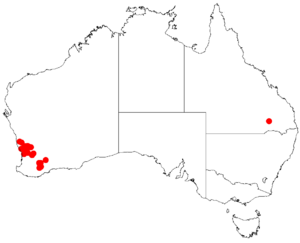Acacia shuttleworthii facts for kids
Quick facts for kids Acacia shuttleworthii |
|
|---|---|
| Scientific classification | |
| Genus: |
Acacia
|
| Species: |
shuttleworthii
|
 |
|
| Occurrence data from AVH | |
Acacia shuttleworthii is a type of shrub that belongs to the Acacia plant family. It is a special plant because it grows naturally only in western Australia. This means it is an endemic species there.
What Does Acacia shuttleworthii Look Like?
This small, bushy plant usually grows to be about 0.25 to 0.5 metres (0.8 to 1.6 ft) tall. Its branches are green and have fine ridges, and they are quite hairy. It has small, pointed leaf-like parts called stipules that stay on the plant. These are about 1 to 3 mm (0.039 to 0.118 in) long.
Like many Acacia plants, it doesn't have true leaves. Instead, it has flattened leaf stems called phyllodes. These phyllodes are shaped like eggs or circles and are about 5 to 16 mm (0.20 to 0.63 in) long and 3 to 11 mm (0.12 to 0.43 in) wide. They are also covered in tiny hairs. Sometimes, they have two or three faint veins on each side.
This plant produces lovely cream-white flowers. It blooms during the spring and early summer months, typically from October to December.
How Was Acacia shuttleworthii Discovered and Named?
The first official description of Acacia shuttleworthii was made by a botanist named Carl Meissner. He wrote about it in 1844. This description was part of a larger work called Plantae Preissianae by Johann Georg Christian Lehmann.
Later, in 2003, another botanist named Leslie Pedley reclassified this plant. He moved it to a different group called Racosperma shuttleworthii. However, in 2006, it was moved back to the Acacia group, where it remains today.
Where Does Acacia shuttleworthii Grow?
Acacia shuttleworthii is found in the Wheatbelt region of Western Australia. It likes to grow on hills and in areas with rocky outcrops. It prefers to grow in a type of reddish soil called lateritic soil.
This plant has a "disjunct distribution." This means its populations are spread out and not continuous. You can find it from around Dandaragan in the north down to Gnowangerup in the south. In these areas, it grows in gravelly clay and sandy soils. It is often found as part of the plant communities in Eucalyptus wandoo woodlands.

